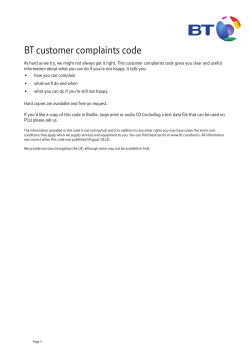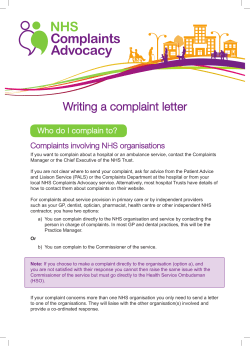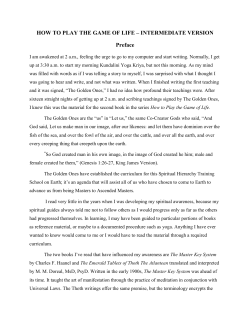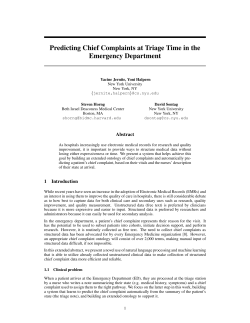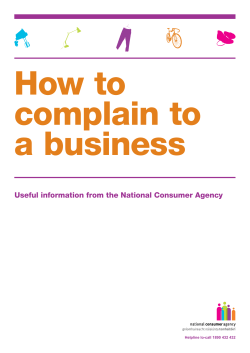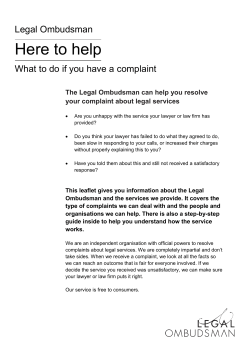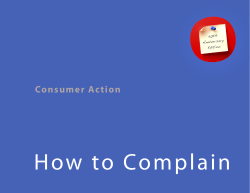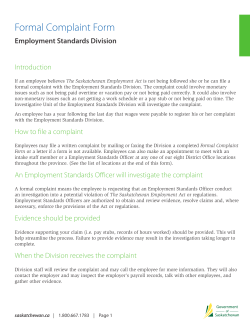
How to Write Response Letters
How to Write Response Letters In this eBooklet, Myra Golden, consumer affairs advisor to such organizations as the Federal Deposit Insurance Corporation, Arvest Bank and Paul Davis Restoration, reveals the 7 Golden Rules for Writing Complaint Response Letters, tips for responding to email complaints and the 4 most common letter writing mistakes – and how to avoid them. When you complete this eBooklet, you will be equipped to quickly generate sincere, complete letters that restore customer confidence in your company after service mishaps have occurred. © Myra Golden Seminars 2002 All rights reserved. Under penalty of law, no part of this publication may be duplicated, reproduced, put on-line, stored in a retrieval system, or transmitted in any form or by any means, electronic, mechanical, photocopying, recording, or otherwise without prior written consent of Myra Golden. www.myragolden.com 1 4 Deadly Mistakes Companies Make When Writing Response Letters 1. Sending out a “canned” letter An airline passenger found a roach in his salad. Upon arriving at his hotel that evening he immediately wrote an angry letter to the airline. By the time he returned to his office from the business trip, a reply from the airline awaited him. The letter read “Dear Sir: Your letter caused great concern to us. We have never before received such a complaint and pledge we will do everything within our power to insure such an incident will never happen again. It might interest you to know that the employee serving you has been reprimanded and the entire plane is being fumigated. Your concern has not fallen on deaf ears.” Needless to say, the man was impressed. Then he noticed an interoffice memo inadvertently stuck to the back of his letter with this message: “Send this character the regular ‘roach letter’.” Canned or form letters, while convenient, are not well received by customers. If you choose to use form letters, use them as templates and take the time to customize each letter to specifically address the customer’s situation. 2. Giving a Delayed Response The speed of the response can have more of an impact on future loyalty than the actual resolution itself. TARP, Inc. found that 95% of dissatisfied customers experiencing minor problems will remain loyal if their complaints are resolved immediately. That number drops to 70% if the resolution is not immediate. There’s no question that in call centers telephone calls take higher priority than written correspondence, but responding to complaint letters and emails must be a very high priority or customer defection rates will surely manifest this neglect. © Myra Golden Seminars 2002 2 3. Failing to Mirror Emotional Content of Letters If your best friend writes you a six page letter describing her man troubles, financial woes, career blues, her disgust with her weight, etc, would you write her back a 2 paragraph canned response? Of course you wouldn’t! That would be an insult and you’d jeopardize your future relationship with this “best” friend. Customers are our friends too. When an unhappy customer takes the time to type up a two page single-spaced letter of complaint, we insult them when we respond with a two or three paragraph “standard complaint” letter. Regaining goodwill is not just about solving the problem, it’s about showing that you care, expressing empathy and connecting with the customer. Mirror customer letters by writing response letters that pace the length and emotion of the customer’s letter. (This does not mean you have to send an 8page letter to a customer who complains line by line for 8 pages. It does mean your letter needs to be carefully thought out and structured and at least a full page with serious loyalty-regaining content.) 4. Sounding As If You Don’t Want to Be Contacted I recently contacted my utility company via email about my bill. The company’s response was prompt and the representative’s email ended with this statement: “Please don’t hesitate to reply or call me if you have any questions.” And the representative’s name, email address and phone number was included in the email signature. It was clear that this company was available to me, should I have any further questions. But this isn’t the case with all companies. I have received response letters from companies that actually did not include a contact name or number. The letter simply “ended”. This is never acceptable. Always leave the door open for customers who do not perceive the situation as resolved. www.myragolden.com 3 Writing Response Letters That Restore Customer Confidence In the Company Last year at Myra Golden Seminars we experimented with changing our primary company color from royal blue to lime green (don’t ask why). We tested client reaction to the idea by desktop printing all workbooks, handouts and promotional materials in the new color during all of our spring seminars. After the first test of the new color scheme I received this email from a participant of my Loyalty Advantage seminar. From: To: Subject: Date: Lorena Boese Myra Golden Feedback May 1, 2001; 9:03 AM I found the print on your workbook hard to read. Those of us over 40 sometimes have difficulty reading certain fonts and colors and I had a hard time following your information and I think I missed out on important tips. Perhaps a darker color, like black or blue would be easier. My ego was a bit bruised as green is my favorite color and the change to lime green was, of course, my idea. But the whole point of testing the color was to make sure it was a good move before committing. My client’s feedback was valuable in helping us make our decision. I personally wrote the response email, following my Golden Rules (that you’ll experience in this eBooklet) and here it is: From: To: Subject: Date: Myra Golden Lorena Boese Feedback May 1, 2001; 9:49 AM (response sent within 1 hour of receiving complaint) Thank you for your feedback on our seminar workbooks. We appreciate customers who take the time to tell us how to we can better serve them. (Expressing appreciation for feedback) It must have been terribly frustrating for you to sit through our seminar and not be able to take full advantage of the workbook. (Showing empathy for the inconvenience the customer experienced) © Myra Golden Seminars 2002 4 Please accept my sincere and unreserved apology for the inconvenience you experienced in not being able to easily follow the outline in the workbook. (Offering sincere apology) Would you believe we usually do use only black and blue fonts? This spring we’re testing a new color scheme to see how clients will respond. Your feedback will prove invaluable as we sit down and decide whether or not to move forward with the change. We will immediately send you a new workbook with black print. We will ship that today. (Telling customer what we’re going to do/responding with a sense of urgency) Ms. Boese, I’m eager to restore your confidence in our company and regain your goodwill. As a concrete form of apology, I am also sending you a disk with my PowerPoint presentation. (Adding something to resolution, as a gesture of goodwill) You can share these slides with your co-workers, employees, and bosses so everyone can work together creatively and strategically to develop a service strategy that makes customers love you, come back again and again and tell everyone they know. Please email me or call me if I have not completely regained your goodwill. (Inviting customer to stay in touch if not satisfied) Thanks for attending yesterday’s seminar and thank you for your valuable feedback on our workbook print. Myra Golden Principal, Myra Golden Seminars 918-355-3532 myra@myragolden.com By the way, my partner and I decided to stay with the royal blue print for our logo and materials. He never liked the idea of lime green and I knew if one customer had a problem with it, there were likely 20 – 30 other people who found it frustrating but chose not to say anything. Responding to complaints received by letter is no different than responding complaints by phone. You’ll want to respond with a sense of urgency, personalize the response, express empathy, offer a sincere apology and ensure customer satisfaction. In my letter writing labs, I give participants the Golden Rules for Regaining Goodwill (taken from the 10 Golden Rules in the Customer Recovery I: How to Keep Customers In Love After a Service Mishap seminar) as a template and have them develop written responses as carefully as they would verbal responses based on the Golden Rules. www.myragolden.com 5 The 7 Golden Rules for Writing Complaint Response Letters I quickly drafted the email in the example on page four using the 7 Golden Rules for Writing Complaint Letters. The rules are simple, make letter writing easy and successfully regain customer goodwill after a service mishap. Before sending out any written response to letters or emails, go through the 7 Golden Rules and make sure you’ve covered all of the bases. 1. Express appreciation for feedback A lot companies begin complaint response letters with: “We have received your letter dated…” Don’t do this. The fact that you’re responding to the letter is irrefutable proof that you have received the customer’s letter. Instead of wasting words, immediately go into a response designed to restore the customer’s confidence and regain their goodwill. My favorite approach to beginning a complaint letter is to begin by expressing appreciation for the feedback. Here are some ways to express appreciation for customer feedback: ! “Thank you for taking the time to write to us.” ! “Thank you for your letter. We appreciate customers who let us know when things aren’t right.” ! “Thank you so much for taking the time to write to us. We appreciate the opportunity to clarify what we think has happened.” (This is ideal for a response letter to a customer who is actually responsible for the error or when you cannot honor the customer’s request for a refund or exchange.) 2. Show empathy If you’ve participated in one of our seminars, you’ve no doubt heard me preach on the value of empathy. Empathy can be a powerful tool used to disarm an angry customer and show that © Myra Golden Seminars 2002 6 you genuinely care about the inconvenience the customer has experienced. Not to be confused with sympathy, empathy is Identification with and understanding of the customer’s situation and feelings. You can express empathy by saying something similar to, “It must have been very frustrating for you have waited 5 days for your order and for that I am sorry.” 3. Apologize Make a note of this rule: Never send out a response letter without an apology. Never. Research has found that when an apology is perceived as genuine, customer satisfaction increases 10% –15%. An apology should be offered both when the company is responsible for the problem and when the company is not responsible. An apology does not have to be an admission of fault. For example, you might say, “I’m so sorry for any misunderstanding you have experienced.” Or “If I were in your shoes, I’m sure I’d feel just as you do. I’m sorry for the frustration you have experienced.” 4. Respond with a sense of urgency (This includes both responding immediately and expressing a sense of urgency about regaining goodwill.) Ninety-five percent of complaining customers will remain your customer if their problems are resolved immediately. Immediately meaning that visit or that phone call. This is compared to only 70% when there is a delay in resolution. To maximize your opportunity to regain goodwill and keep the customer, you’ll want to work with and demonstrate a sense of urgency. Make it clear that resolving the problem is as important to you as it is to the customer. You can demonstrate a sense of urgency with your words, tone and literally by moving quickly to resolve the problem. In the example response email from page 4 of this eBooklet, I demonstrated a sense of urgency at two points: www.myragolden.com 7 A. “We will immediately send you a new workbook with black print. We will ship that today.” B. “Ms. Boese, I’m eager to restore your confidence in our company and regain your goodwill. As a concrete form of apology, I am also sending you a disk with my PowerPoint presentation.” 5. Tell the customer what you’re going to do Clearly explain to the customer exactly what you plan to do to resolve the problem. This is especially important if the resolution will take some time. 6. Give them double for their trouble (Add a goodwill token like a coupon or a complimentary product) In my email to Ms. Boese, I did this with this statement: “I am also sending you a disk with my PowerPoint presentation.” Sometimes in complaint resolution, it is appropriate to add a little something to the recovery to ensure customer goodwill. This can be as simple as a coupon inviting the customer to come back and try your product or service at a discount. It won’t always be necessary to make it a double for their trouble but doing this can help maintain and strengthen loyalty. 7. Invite customer to contact you if they aren’t satisfied Make it easy for your customers to contact you if they need more information. Always give your name, toll-free number, email address and website. When you respond to complaint letters and emails using the 7 Golden Rules, your letters will be customized, sincere and professional and they will not only deliver a resolution, but will facilitate your restoring the customer’s confidence in the company and maintaining customer loyalty. © Myra Golden Seminars 2002 8 Response Time Guidelines A question I’m frequently asked is “What is a reasonable response time for complaint letters?” The answer: The faster, the better. Research by TARP, Inc. found that organizations can increase loyalty after a complaint if: 1. The customer receives an immediate reply acknowledging letter 2. The customer receives satisfactory resolution within 2 weeks I know it isn’t always feasible to resolve complaints within 2 business days, either because the resolution requires research or because call volume does not afford you the time to respond to letters as promptly as you would like. When you’re not able to respond with a resolution within 2 days, simply send out an initial reply immediately upon receiving the customer’s letter. When I was overseeing consumer affairs, here’s the letter I created for my staff to use when resolution couldn’t be immediately offered: Thank you so much for taking the time to write to us. Your letter has been forwarded to (responsible representative’s name) and you can expect a reply within 10 business days. Should you need to reach us sooner, please contact (responsible representative) directly at 1-800-000-0000 x 000. This simple letter allowed us to stay in communication with customers without causing a breakdown in workflow during peak volume times. Responding to Email Complaints In 1999, when I was heading up consumer affairs at Thrifty, we realized more than a 300% increase in complaints via email over 1998. The trend continued in 2000 with a 264% increase over the previous year. We were scrambling to keep up, as postal mail and phone complaints did not decrease. We discovered that customers who voiced complaints by email were a new group of customers. This was a group of customers who probably weren’t likely to complain if it were not for the convenience of being able www.myragolden.com 9 to sit at a computer at 3am and sending a note of complaint. Many of these complaints were minor, most not even disputing a dollar amount. But they were complaints and we had to respond. At that time, Thrifty had a goal of resolving all complaints that came by mail within 10 business days. As a trailblazing ecommerce consumer myself, I knew that a ten-day response to email complaints was definitely taboo. So I did a little survey to benchmark what other corporate customer care departments were doing. I contacted 10 companies by email with a complaint in order to test their speed of response. The companies represented included a large manufacturer of home computers, an international hotel chain, a restaurant, wireless phone company, a bookstore, and of course, a car rental company. (In order to protect the guilty, I won’t reveal the company names.) Of the ten companies, only one responded immediately. The wireless phone company sent an automatic response within minutes and a detailed answer in less than 10 hours. The computer company responded 28 days later and not one of the other 8 companies even bothered to respond! My survey told me that many companies are failing customers miserably and that any effort I took would take Thrifty to the top of the game. E-commerce experts seem to agree that an immediate response is expected for all email inquiries - immediate being within the hour – and the final answer/resolution must be given within 2 business days. According to recent research by Jupiter Research (www.jmm.com) only one third of companies bother to immediately acknowledge they received a customer’s email by sending an automatic response. In Jupiter’s research, most companies did eventually respond, but only 52% did so within 24 hours and 32% took three days or longer, or did not respond at all. Research shows that 59% of high-spending consumers (those who spend more than $500 online over 6 months) expect a resolution to an email inquiry within 24 hours. It’s important for companies to meet customers’ expectations for email response, otherwise your customers may initiate communication via more expensive means – live operators, postal mail, etc. Or worse, your customers may defect to the competition and spread negative word-of-mouth advertising. © Myra Golden Seminars 2002 10 7 Simple Guidelines for Responding to Email Queries 1. Check emails as frequently as you check the phones. You answer the phones every time they ring and emails should be treated the same way. It’s not acceptable to check customer emails one or two times daily or hourly. Email response must be a priority. 2. Send an initial reply immediately – certainly no later than 1 business day. The easiest and most economical means for an initial reply is to have an automatic reply setup through your complaint tracking system or other software package. Some software packages are sophisticated enough to read the customer’s email, pick up on key words and reply based on email content. Other, simpler, packages simply respond with content you input. At Thrifty, we simply said: Thank you for contacting us. Your email has been forwarded to our Customer Care Department. We will contact you within 5 business days. 3. Reply via email. Customers contacting you by email are suggesting that email is their preferred method of communication. Unless absolutely necessary, avoid calling or sending a response via postal (snail) mail. (Obviously, refunds or token items would still be sent postal mail.) 4. Resolve problem within 3 – 5 business days. The sooner the better. Email customers do not have tolerance for a 10-day turnaround. Five days is actually stretching it. Strive for immediacy. 5. Activate the spell-check feature. Spelling counts. Always, always proof emails. www.myragolden.com 11 6. Capture and archive emails in your CRM system. It’s critically important to log all email communications (both to and from the company) in your customer relationship management (CRM) system with dates and times. This helps you when emails are escalated, information is misinterpreted or there is an accusation of no response from the company. 7. Post a FAQ section on your company’s Contact Us page. Identify the top 10 reasons customers email your company and post responses to these queries on your website. Doing this can reduce the number of emails coming into your department or can better prepare your staff to respond. For example, At Thrifty Rent-A-Car System hundreds of customers contact Customer Care each month requesting a copy of a past rental agreement. The Customer Care Department has created a form on the website specifically for customers requesting a rental agreement. Amazon.com has forecasted dozens of FAQ customers are likely to encounter and listed them on their site. © Myra Golden Seminars 2002 12 4 Quick Letter Writing Tips: 1. Quickly get to the point. Customers await responses from companies with great anticipation. Don’t use your response letter as an opportunity to promote products or services. And by all means, don’t waste words. Simply express appreciation for the feedback, apologize for the problem and quickly offer your resolution strategy or explanation. 2. Tell the customer what you can do. Even when you can’t give the customer exactly what they’re asking for, you should make every offer to help them. Make a point to emphasize what you can do for your unhappy customer rather than what you cannot do. When you give your customers options and clearly work to help them, you’re much more likely to regain customer goodwill and maintain the customer’s loyalty. 3. Keep Sentences Short. A good average sentence length for business correspondence is in the range of 14 to 20 words. Readability studies show that people can quickly comprehend a 20-word sentence and move on to the next thought. A 30-word sentence causes them to slow down, however, and a 40-word sentence may require rereading. 4. Avoid Jargon. Make sure your letter doesn’t contain acronyms or terms not easily interpreted. All customer correspondence needs to be simple and crystal clear. www.myragolden.com 13 Conclusion Responding to complaint letters doesn’t have to be difficult. Make sure your responses are sent out immediately, that they mirror the customer’s pace and emotions and always follow the 7 Golden Rules. When you follow our simple letter generating process, you will find that your letters not only resolve problems, but they also restore the customer’s confidence in your company and regain goodwill. Myra Golden delivers customer loyalty and customer recovery seminars for companies that are serious about improving customer profitability, speaks at conferences and conventions, and facilitates problem solving and process improvement sessions. Her customers include such enterprises as Procter & Gamble, the FDIC, Scotts LawnService and Vistakon, a division of Johnson & Johnson. She can be reached by email at Myra@MyraGolden.Com or at 866873-8419. She also has a website: www.myragolden.com. © Myra Golden Seminars 2002 14
© Copyright 2025

